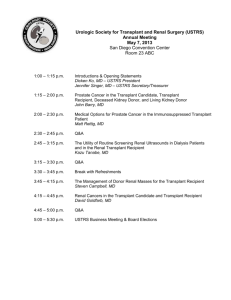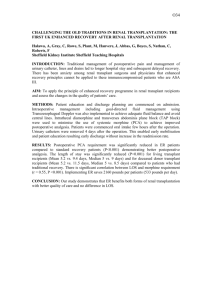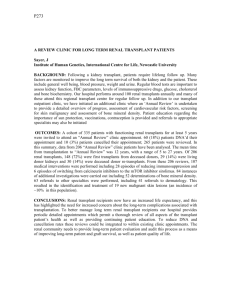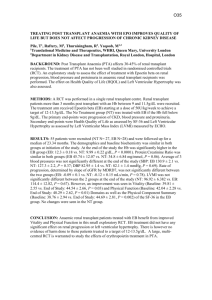Polling question – Staff Safety Assessment (SSA)
advertisement
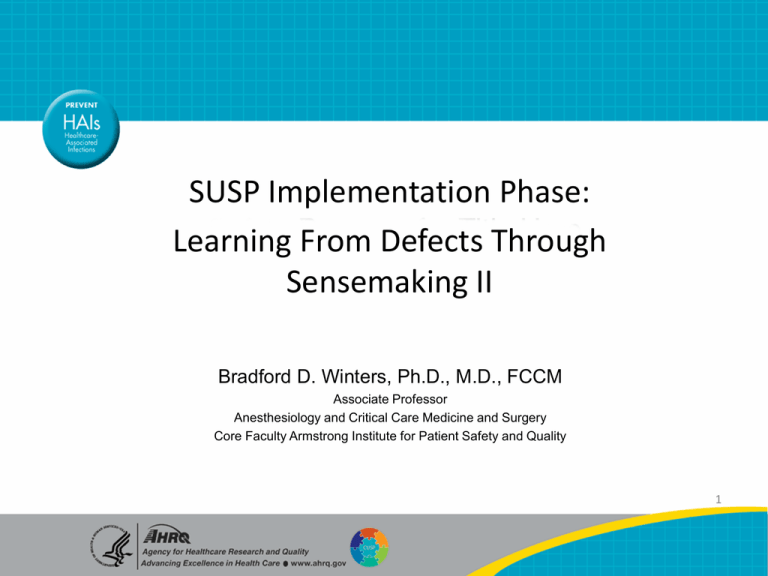
SUSP Implementation Phase: Learning From Defects Through Sensemaking II Bradford D. Winters, Ph.D., M.D., FCCM Associate Professor Anesthesiology and Critical Care Medicine and Surgery Core Faculty Armstrong Institute for Patient Safety and Quality 1 Polling Questions • • • • • What is your role? Have you established your SUSP team? Has your team started meeting regularly? Is your team already working on specific defects? Where are you from? Enter organization in the chat box. 2 Learning Objectives • Use the Learning For Defects (LFD) tool to perform second-order problem solving • Create an action plan to address prioritized contributing factors • Evaluate the effectiveness of your intervention by measuring baseline and post-intervention performance • Present your findings to surgical department leadership 3 Learning from Defects What happened? From view of person involved Why did it happen? How will you reduce it happening again? How will you know the risk is reduced? 4 Communicating for Patient Safety CASE STUDY: RENAL TRANSPLANT 5 Case Study: Renal Transplant Setting the stage • • • • • Who: What: When: Where: And: An ICU patient bleeding after renal transplant Needs emergency surgery to correct Early morning 0530 Taken to OR by anesthesiology team Nurse hands over chart with Kardex stamp plate as patient is on the way out of ICU What happened next? • In OR: Patient unstable on arrival to OR at 0600, necessitating additional lines • In OR: Patient stabilized and surgery begins 6 Case Study: Renal Transplant • Attending anesthesiologist called to an emergent neurosurgical case for craniotomy • Attending leaves renal transplant case, returns at 0730 • Meanwhile, nursing and OR tech staff turned over at 0700 • Anesthesiology resident who started the case has already signed out to the day shift resident who has taken over • Attending notes that a transfusion has started, and that the PRBCs bag has the wrong patient’s name • Attending immediately stops the transfusion, reporting error to the OR staff and blood bank 7 Case Study: Renal Transplant • • • • Resident used the stamp plate to order and then check the blood However, wrong chart sent with the patient from the ICU Never checked against the wrist band All of the OR documents stamped with the name from the incorrect chart • Ultimately, the patient dies, though transfusion not the cause as the donor blood was type O 8 Case Study: Renal Transplant Learning from Defects Tool • How will you reduce the risk of the defect happening again? • How will you know the risk is reduced? 9 Case Study: Renal Transplant System Failures Knowledge, Skills & Competence Anesthesiology attending not notified of the transfusion; wrist band checks with stamp plate were not done at multiple points Opportunities For Improvement Create independent checks, encourage patient safety culture initiatives, add system constraints like barcoding technologies Unit Environment Near simultaneous emergent events; change of two different provider groups at same time; no independent check Stagger staff changes Formalize hand-offs between departments Other Factors Hospital environment: Transfer across units Patient characteristics: High acuity Task characteristics: Blood check-in only as good as existing identity documents Ensure hand-off process supports emergencies 10 How Will You Reduce Risk Reoccurring? Pick a contributing factor to address first • What is its impact on causing the defect? • Does it occur rarely or have a high likelihood of reoccurring? 11 How Will You Reduce Risk of Happening Again? Create choices by brainstorming possible interventions • Involve the entire team with flipcharts and post-its • Prioritize most important contributing factors and most beneficial interventions • Take advantage of your diverse team! – Senior Executive’s big picture view of the organization and knowledge of resources – Team members’ connections throughout organization – Frontline staff with particular insight into the defect 12 How Will You Reduce Risk of Happening Again? Make choices and select your intervention • Have your team vote on its favorite solutions • Consider rating solutions based on direct and feasible way to address the defect Weaker Intermediate Stronger Telling someone to be more careful Eliminating or reducing distractions Making a process or device “mistake proof” 13 Building Resiliency into Intervention Not all interventions are created equal Forcing functions and constraints Strongest Automation and computerization Standardization and protocols Checklists and independent check systems STRENGTH OF INTERVENTION Rules and policies Education and information Weakest Vague warnings – Be more careful! 14 Not All Education Is Created Equal Either Strive for Concise, Clear and Relevant Messages • Avoid information overload in all manners of disseminating information • Share a concise message with a clear focus relevant to specific audience needs • Experiential learning with hands-on approach will be far more effective at motivating change than an automated email dense with data Email Blast Lecture Handson Training Team Meetings 15 How Will You Reduce Risk of Happening Again? Remember the people side of the intervention • Consider who influences and impacts your intervention • Are they likely to support or resist your intervention? • Create an action plan to get them on board Stakeholder Action Plan to Engage Lead Point on Action Plan Follow-up Date for Lead to Report to Group 16 How Will You Reduce Risk of Happening Again? Engagement is hard! • Use the wisdom of your diverse team to overcome barriers and solve problems • Make sure the intervention details are spelled out and understood by everyone • Ensure the intervention is carried out consistently 17 How Will You Know Risks Were Reduced? • • • • Do staff know about the interventions? Are staff using the interventions as intended? Do staff believe risks were reduced? Subjective evaluations can provide valuable information • Data driven metrics should be the goal whenever possible 18 How Will You Know Risks Were Reduced? • • • • • Identify how you will measure success Put an audit plan in place to track that measure Include a way to feed data back to your group Review your audits and adjust your intervention as needed May require revisiting Learning from Defects process Tip: Learning from defects is a continuous process as is the need to engage frontline staff. 19 How Will You Know Risks Were Reduced? • Evaluate the effectiveness of your intervention by measuring baseline and post-intervention performance • Present your findings to surgical department leadership 20 How Will You Know Risks Were Reduced? Plan Measure of Success Who Measures and How Often Where Recorded Follow-up Date Corrective Action 21 Ongoing Key Questions (SSA) Your Mantra! Patient safety culture requires constant vigilance How is the next patient going to be harmed? What can I do to prevent that harm? Tip: Remember that the Learning from Defects tool addresses both technical tasks and adaptive teamwork issues. 22 Polling question – Staff Safety Assessment (SSA) • Have you asked your frontline staff the two questions? – Yes – No • How often do you ask the two questions? – – – – – – Never At least once a year At least once a quarter At least once a month Every week The SSA questionnaire is available at all times 23 Polling question – Staff Safety Assessment (SSA) • Do you check the responses to the two questions regularly? – No, we forget to check for responses. – No, not regularly. We tend to check when we are ready to work on a new defect. – Yes, at least quarterly – Yes, at least monthly – Yes, at least weekly 24 Action Plan • Review the Learning from Defects tool with your team • Review a defect in your operating rooms • Select one defect per month • Consider using in surgical morbidity and mortality conferences • Post the stories of reduced risks (with data!!) • Share with others 25 References Bagian JP, Lee C, et al. Developing and deploying a patient safety program in a large health care delivery system: you can't fix what you don't know about. Jt Comm J Qual Improv 2001;27:522-32. Pronovost PJ, Holzmueller CG, et al. A practical tool to learn from defects in patient care. Jt Comm J Qual Patient Saf 2006;32(2):102-108. Pronovost PJ, Wu Aw, et al. Acute decompensation after removing a central line: practical approaches to increasing safety in the intensive care unit. Ann Int Med 2004;140(12):10251033. Reason J. Human Error. Cambridge, England: Cambridge University Press, 2000. Vincent C, Taylor-Adams S, Stanhope N. Framework for Analyzing Risk and Safety in Clinical Medicine. BMJ. 1998;316:1154. Wu AW, Lipshutz AKM, et al. The effectiveness and efficiency of root cause analysis. JAMA 2008;299:685-87. 26


